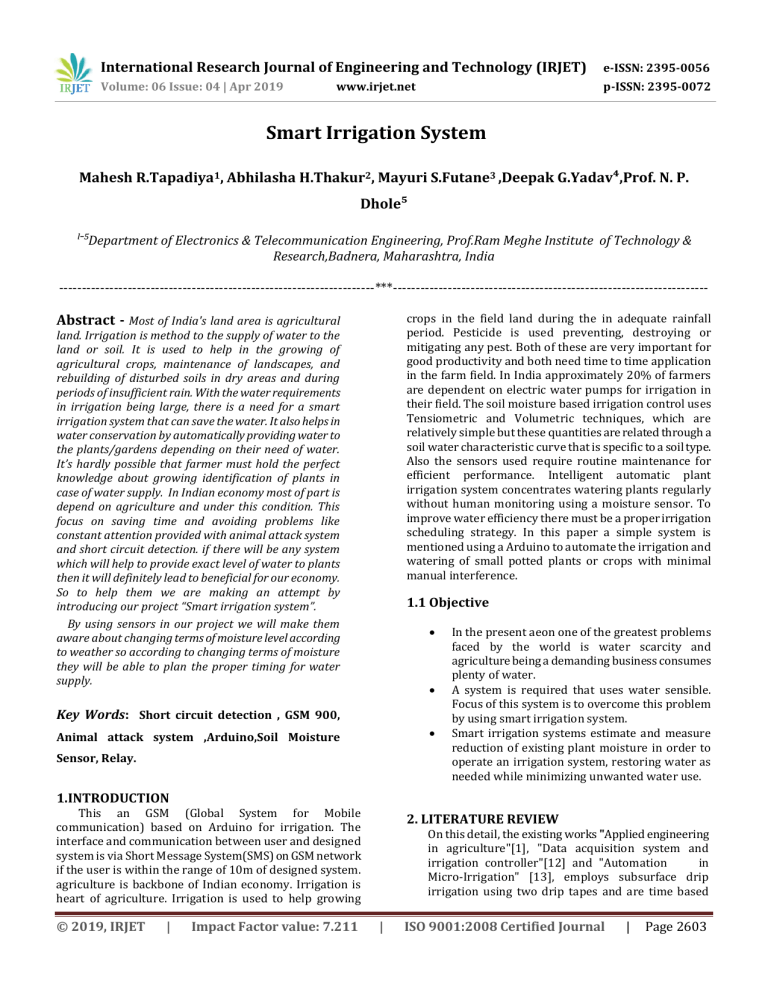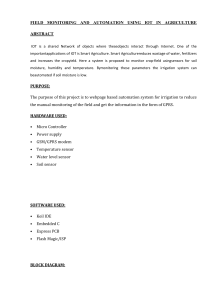IRJET-Smart Irrigation System
advertisement

International Research Journal of Engineering and Technology (IRJET) e-ISSN: 2395-0056 Volume: 06 Issue: 04 | Apr 2019 p-ISSN: 2395-0072 www.irjet.net Smart Irrigation System Mahesh R.Tapadiya1, Abhilasha H.Thakur2, Mayuri S.Futane3 ,Deepak G.Yadav⁴,Prof. N. P. Dhole⁵ ˡ¯⁵Department of Electronics & Telecommunication Engineering, Prof.Ram Meghe Institute of Technology & Research,Badnera, Maharashtra, India ---------------------------------------------------------------------***--------------------------------------------------------------------- Abstract - Most of India's land area is agricultural crops in the field land during the in adequate rainfall period. Pesticide is used preventing, destroying or mitigating any pest. Both of these are very important for good productivity and both need time to time application in the farm field. In India approximately 20% of farmers are dependent on electric water pumps for irrigation in their field. The soil moisture based irrigation control uses Tensiometric and Volumetric techniques, which are relatively simple but these quantities are related through a soil water characteristic curve that is specific to a soil type. Also the sensors used require routine maintenance for efficient performance. Intelligent automatic plant irrigation system concentrates watering plants regularly without human monitoring using a moisture sensor. To improve water efficiency there must be a proper irrigation scheduling strategy. In this paper a simple system is mentioned using a Arduino to automate the irrigation and watering of small potted plants or crops with minimal manual interference. land. Irrigation is method to the supply of water to the land or soil. It is used to help in the growing of agricultural crops, maintenance of landscapes, and rebuilding of disturbed soils in dry areas and during periods of insufficient rain. With the water requirements in irrigation being large, there is a need for a smart irrigation system that can save the water. It also helps in water conservation by automatically providing water to the plants/gardens depending on their need of water. It’s hardly possible that farmer must hold the perfect knowledge about growing identification of plants in case of water supply. In Indian economy most of part is depend on agriculture and under this condition. This focus on saving time and avoiding problems like constant attention provided with animal attack system and short circuit detection. if there will be any system which will help to provide exact level of water to plants then it will definitely lead to beneficial for our economy. So to help them we are making an attempt by introducing our project “Smart irrigation system”. By using sensors in our project we will make them aware about changing terms of moisture level according to weather so according to changing terms of moisture they will be able to plan the proper timing for water supply. 1.1 Objective Key Words: Short circuit detection , GSM 900, Animal attack system ,Arduino,Soil Moisture Sensor, Relay. In the present aeon one of the greatest problems faced by the world is water scarcity and agriculture being a demanding business consumes plenty of water. A system is required that uses water sensible. Focus of this system is to overcome this problem by using smart irrigation system. Smart irrigation systems estimate and measure reduction of existing plant moisture in order to operate an irrigation system, restoring water as needed while minimizing unwanted water use. 1.INTRODUCTION This an GSM (Global System for Mobile communication) based on Arduino for irrigation. The interface and communication between user and designed system is via Short Message System(SMS) on GSM network if the user is within the range of 10m of designed system. agriculture is backbone of Indian economy. Irrigation is heart of agriculture. Irrigation is used to help growing © 2019, IRJET | Impact Factor value: 7.211 2. LITERATURE REVIEW On this detail, the existing works "Applied engineering in agriculture"[1], "Data acquisition system and irrigation controller"[12] and "Automation in Micro-Irrigation" [13], employs subsurface drip irrigation using two drip tapes and are time based | ISO 9001:2008 Certified Journal | Page 2603 International Research Journal of Engineering and Technology (IRJET) e-ISSN: 2395-0056 Volume: 06 Issue: 04 | Apr 2019 p-ISSN: 2395-0072 www.irjet.net systems in which irrigation time clock controllers, or timers, are an integral part of an automated irrigation system. A timer is an essential tool to apply water in the necessary quantity at the right time. Timers can lead to under or over-irrigation if they are not correctly programmed or the water quantity is calculated incorrectly. Time of operation is calculated according to volume of water required and the average flow rate of water a timer starts and stops the irrigation process. It automatically schedules irrigation at random events by using timers where in the automation for the system and displays were not implemented. water and the controller measures these pulses to keep a check on the supply. The proposed system is employed using microcontroller. In this regard, the books, "The 8051 micro controller"[3], "Design with micro controllers "[5], "Hand-Book of micro controllers"[7], "Embedded micro controller systems"[9] and “The 8051 micro controller” [11], give an overview of the 8051 microcontroller. They have even helped us to gain valuable programming knowledge and practical examples of instructions given illustrate how these instructions function. Complex hardware and software application examples are also provided. The papers titled " Feedback Control for Surface Irrigation Management "[2] and "Control and Automation in Citrus Micro-Irrigation Systems" [16], employs open loop systems in which the operator makes the decision on the amount of water to be applied and the timing of the irrigation event. The controller is programmed correspondingly and the water is applied according to the desired schedule. Open loop control systems use either the irrigation duration or a specified applied volume for control purposes. Open loop controllers normally come with a clock that is used to start irrigation. Termination of the irrigation can be based on a pre-set time or may be based on a specified volume of water passing through a flow meter. In an open loop system, the operator makes the decision on the amount of water that will be applied and when the irrigation event will occur. This information is programmed into the controller and the water is applied according to the desired schedule. Open loop control systems use either the irrigation duration or a specified applied volume for control purposes. The drawback of open loop systems is their inability to respond automatically to changing conditions in the environment. In addition, they may require frequent resetting to achieve high levels of irrigation efficiency. 3. METHODOLOGY 1.1 Block Diagram & Description: Fig-1: Block diagram Working In this a system has Arduino, Soil moisture sensor, Temperature sensor, Relays, buzzer and GSM Module. This system is having four subsystems such as Animal Attack, Short Circuit Detection, Self-mode and Manual mode. A switch is used to change the mode of the system in manual or self-mode. There is a manual mode in which PUMP will be controlled manually by sending message to a system through GSM while another mode is automatic which is controlled by Arduino will get the inputs from Sensors such as temperature, soil moisture and as per that Arduino will make the PUMP ON or OFF. And at the same time will send the same status to the system for security. when system is made on Arduino will keep the Relays OFF. And check for the Mode switch whether to work in MANUAL mode or self-Mode. The papers titled, " Drip irrigation scheduling of tomato"[4] and "Design of a Micro-Irrigation System Based on the Control Volume Method" [15], employ volume based systems. The pre-set amount of water can be applied in the field segments by using automatic volume controlled metering valves. It’s depicted that the volume control systems are more advantageous than time control systems. The amount of water these systems supply is fixed irrespective of continuous electricity availability but still time controlled systems are more popular as they are less expensive. Here volume meters are connected, which emits a pulse after delivering a specific amount of © 2019, IRJET | Impact Factor value: 7.211 In self- mode, Moisture Sensor senses the low moisture content of the soil and gives a signal to the Arduino. If moisture level is low, then relay will turn on the motor | ISO 9001:2008 Certified Journal | Page 2604 International Research Journal of Engineering and Technology (IRJET) e-ISSN: 2395-0056 Volume: 06 Issue: 04 | Apr 2019 p-ISSN: 2395-0072 www.irjet.net pump. When the moisture content becomes sufficient, the sensor senses this and gives back the signal to the Arduino, Relay gets open and the water pump become turn OFF. Temperature sensor gives the value of temperature to Arduino, according to temperature value, motor will be turn ON or OFF. In manual mode, Arduino keep checking for the incoming message with the help of GSM and if it gets a new message then Arduino reads the content of the message and accordingly turn ON or OFF the motor. Overload relays are used in a motor circuit to protect motors from damage caused from ove0rcurrent. Short circuit protection is protection against excessive currents or current beyond the acceptable current rating of equipment and it operates instantly. When the animal will enter in the land then buzzer will on and it will intimidate to the animal and also send message to the user for the security purpose. Fig-3: Analysis of short circuit detection 3.2Actual Application Result: This smart irrigation system shows all values moisture content of soil and according to that it will on or off the motor. This system will protect the land from the animal with the help of buzzer. Short circuit detector used to avoid the damage of circuit from the over flow of current. This system can be controlled in two modes such as selfmode and manual mode with the help of GSM. Fig-3:System on/off 4.Hardware description: Fig-2: Analysis of animal attack Fig-5:Actual Picture © 2019, IRJET | Impact Factor value: 7.211 | ISO 9001:2008 Certified Journal | Page 2605 International Research Journal of Engineering and Technology (IRJET) e-ISSN: 2395-0056 Volume: 06 Issue: 04 | Apr 2019 p-ISSN: 2395-0072 www.irjet.net 5.CONCLUSION Most of the population in the world has an occupation of farming most people who does businesses depending upon farming the population will increase verity. The GSM Based Smart Irrigation System will be monitors and controls all the activities of irrigation system efficiently. GSM Based Smart Irrigation System will be a better circuit for accurate soil moisture control and is a simple, specific method of irrigation. It will also help in time saving, removal of human error in adjusting available soil moisture levels and to maximize their net profits. 6. FUTURE SCOPE Pesticides and fertilizer can be added automatically into the water. PIR sensors can be used to detect the motions of animal in the agriculture filed. The system can be powered by solar panel, solar controller can be used to control the power of system. Implementation of weather forecasting will help in saving the water based on the availability of water. It can be add on Bluetooth technology for wireless sensors. We can interface lcd screen in order to display the current status of system. 7. REFERENCES [1] SMAJSTRLA, A.G.; KOO, R.C...(1 9 8 6 ). "Applied engineering in agriculture". [2] CLEMENS, A.J. (1990).Feedback Control for Surface Irrigation Management in: Visions of the Future. ASAE Publication 04-90. American Soceity of Agricultural Engineers, St. Joseph, Michigan, pp.255260. SCOTT MAC. KENZIE, The 8051 micro controller, second edition, pretice hall Inc., USA, (1995) pp. 81 94. SMAJSTRLA, A.G.; LOCASCIO, S.J. (1996). "Drip irrigation scheduling of tomato",12(3):312-319. [3] [4] © 2019, IRJET | Impact Factor value: 7.211 | ISO 9001:2008 Certified Journal | Page 2606



